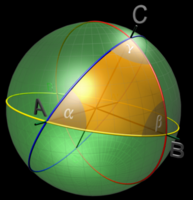I'm not quite clear on what exactly you are given, but I will give you some suggestions that may help you. I'm going to assume that you can begin with the center of the sphere and a normal vector [MATH]\vec N[/MATH] of the plane of the great circle you want. For example, using spherical coordinates, you might have a unit normal [MATH]\vec N = \langle \sin\phi \cos\theta,\sin \phi \sin\theta,\cos\theta\rangle[/MATH], where you know [MATH]\phi[/MATH] and [MATH]\theta[/MATH]. To save typing, I will just call this vector [MATH]\vec N =\langle a,b,c \rangle[/MATH]. You can make a vector [MATH]\vec u[/MATH]perpendicular to [MATH]\vec N[/MATH] by taking [MATH]\vec u =\langle -b,a,0\rangle[/MATH] as an example. Then you can make another vector [MATH]\vec v[/MATH] perpendicular to both [MATH]\vec u[/MATH] and [MATH]\vec N[/MATH] by taking [MATH]\vec v = \vec u \times \vec N[/MATH]. Finally, make unit vectors [MATH]\hat u =\frac{\vec u}{|\vec u|},~\hat v =\frac{\vec v}{|\vec v|}[/MATH]. These are orthogonal unit vectors in the plane of the great circle you want. So if [MATH]\vec c[/MATH] is a position vector to the center of the sphere, and [MATH]r[/MATH] is its radius, a parametric equation of the circle you seek is [MATH]\vec R(t) = \vec c +r\cos (t) \hat u + r\sin (t) \hat v,~0\le t \le 2\pi[/MATH]. The arithmetic can get a bit messy but it's easy enough to understand and execute in something like Maple.
Also note that you don't have to use spherical coordinates. You could just start with any normal vector [MATH]\langle a,b,c \rangle[/MATH]


